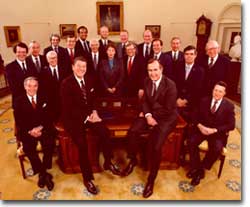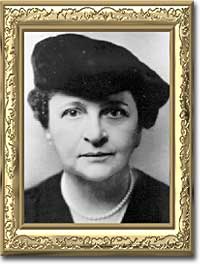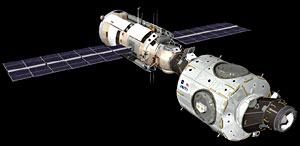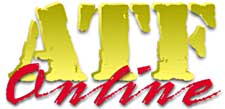How Do Regulatory Commissions Differ From Agencies That Provide Services To The Public

8b. The Organization of the Bureaucracy

Along with the Vice President, the President's Cabinet members are his most important advisors. This picture shows President Reagan, Vice President Bush, and Cabinet members in the Oval Office.
Even the experts tin't agree on the total number of federal government agencies, commissions, and departments.
Almost estimates suggest there are probably more than 2,000 of these. They each accept an area of specialization — some much broader than others — merely their duties ofttimes overlap, making administration more difficult. To complicate things even more, many agencies have counterparts at the state and local level. Its size, complexity, and overlapping responsibilities leave the federal hierarchy open to constant attempts to reorganize and streamline.
Congress has the power to create, organize, and disband all federal agencies. Virtually of them are under the control of the President, although few of them actually accept straight contact with the White House. And then, the bureaucracy has two masters — Congress and the President. The bureaucracy generally falls into iv broad types: Chiffonier departments, government corporations, independent agencies, and regulatory commissions
The Cabinet Departments
The 15 Cabinet departments are each headed by a Secretary who sits on the President'due south Chiffonier. The exception is the Justice Section, which is headed by the Attorney Full general, who is also a member of the President's Cabinet. The Secretaries are responsible for directing the section's policy and for overseeing its operation. Cabinet secretaries are usually torn between their responsibilities every bit presidential advisers and heads of their departments.

Equally the commencement woman Chiffonier fellow member, Frances Perkins served for 12 years, helping draft legislation such as the Social Security Human activity and the first federal minimum wage laws.
Each has a special surface area of policy, although their responsibilities are still very wide. The organization of each is quite complex, only they have some things in common. All Secretaries accept a Deputy or Undersecretary, as well as a host of Assistant Secretaries, who all directly major programs within the section.
Most departments are divided into bureaus, divisions, and sections. For example, the FBI lies within the domain of the Justice Section, and the Surreptitious Service is currently within the Treasury Departmeny agency, but soon to be moved under the auspices of the Department of Homeland Security .
Government Corporations
Regime corporations do not belong to whatsoever department — they stand on their ain. Probably the best-known government corporations are the United States Mail service and Amtrak. They are different from other agencies in that they are businesses created by Congress, and they charge fees for their services. Like any other business, regime corporations take private contest — such as Federal Express and United Parcel Service — and sometimes state competition — such as the New Jersey Transit Dominance.

At the time of its cosmos, NASA was causeless by many to be a defense-related agency. Today, it brings nations together in highly publicized efforts like the International Space Station shown here.

Contained Agencies
Contained agencies closely resemble Cabinet departments, merely they are smaller and less circuitous. Generally, they have narrower areas of responsibility than practise Chiffonier departments. About of these agencies are not costless from presidential control and are independent simply in the sense that they are non office of a department.
Congress creates them as carve up agencies for many reasons, practical likewise every bit symbolic. For example, when the National Helmsmanship and Space Administration (NASA) was established, many members of Congress assumed that information technology would be a part of the Department of Defense. However, it is an contained agency because the space plan has many other purposes than the defence force of the nation.

The ATF (at present the Agency of Alcohol, Tobacco, Firearms, and Explosives) was transferred from the Department of the Treasury to the Department of Justice in 2006.
Regulatory Agencies
These agencies regulate of import parts of the economic system, making rules for large industries and businesses that impact the interests of the public. Because regulatory commissions are "watchdogs" that by their very nature need to operate independently, they are not part of a section, and the President does not directly control nearly of them. Each commission has from 5 to xi members appointed by the President, but the President cannot remove them for the length of their terms in function.
Examples of these commissions are the Securities and Exchange Commission, which regulates the stock market, brokers, and investment practices. Another well-known commission is the Federal Reserve Board that governs the nation's monetary policy. The Environmental Protection Agency serves as a guardian over the nation's environment, making and enforcing standards for the industrial and commercial sectors.
With over 2,000 dissimilar agencies, the federal bureaucracy is almost certain to run into issues with organization, overlapping responsibilities, and efficiency. Almost every recent President has come into part determined to refashion and trim the bureaucracy. Nonetheless, none has been able to brand more than pocket-size adjustments. Well-established agencies accept lives of their own, and are difficult to change. Besides, the country has large, complex, needs requiring special attention. A large bureaucracy is a part of the authorities'south attempt to meet those needs.
![]()
If you similar our content, please share it on social media!

![]()
Source: https://www.ushistory.org/gov/8b.asp
Posted by: beauchampsevenjoy.blogspot.com


0 Response to "How Do Regulatory Commissions Differ From Agencies That Provide Services To The Public"
Post a Comment